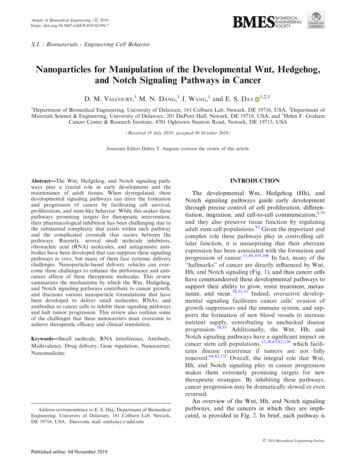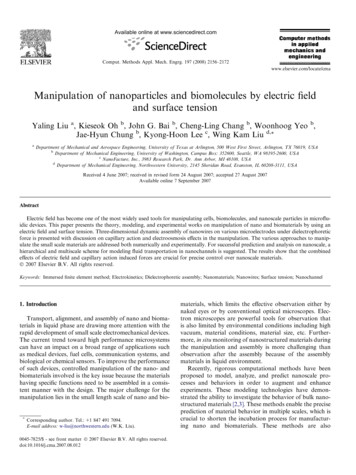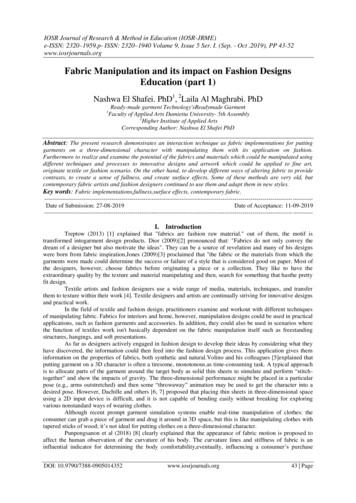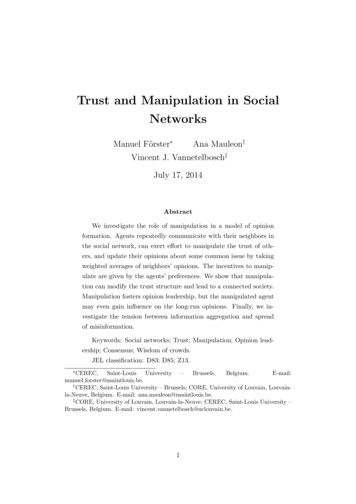
Transcription
BIOMEDICALENGINEERINGSOCIETYAnnals of Biomedical Engineering (Ó . : Biomaterials - Engineering Cell BehaviorNanoparticles for Manipulation of the Developmental Wnt, Hedgehog,and Notch Signaling Pathways in CancerD. M. VALCOURT,1 M. N. DANG,1 J. WANG,1 and E. S. DAY1,2,31Department of Biomedical Engineering, University of Delaware, 161 Colburn Lab, Newark, DE 19716, USA; 2Department ofMaterials Science & Engineering, University of Delaware, 201 DuPont Hall, Newark, DE 19716, USA; and 3Helen F. GrahamCancer Center & Research Institute, 4701 Ogletown Stanton Road, Newark, DE 19713, USA(Received 29 July 2019; accepted 30 October 2019)Associate Editor Debra T. Auguste oversaw the review of this article.Abstract—The Wnt, Hedgehog, and Notch signaling pathways play a crucial role in early development and themaintenance of adult tissues. When dysregulated, thesedevelopmental signaling pathways can drive the formationand progression of cancer by facilitating cell survival,proliferation, and stem-like behavior. While this makes thesepathways promising targets for therapeutic intervention,their pharmacological inhibition has been challenging due tothe substantial complexity that exists within each pathwayand the complicated crosstalk that occurs between thepathways. Recently, several small molecule inhibitors,ribonucleic acid (RNA) molecules, and antagonistic antibodies have been developed that can suppress these signalingpathways in vitro, but many of them face systemic deliverychallenges. Nanoparticle-based delivery vehicles can overcome these challenges to enhance the performance and anticancer effects of these therapeutic molecules. This reviewsummarizes the mechanisms by which the Wnt, Hedgehog,and Notch signaling pathways contribute to cancer growth,and discusses various nanoparticle formulations that havebeen developed to deliver small molecules, RNAs, andantibodies to cancer cells to inhibit these signaling pathwaysand halt tumor progression. This review also outlines someof the challenges that these nanocarriers must overcome toachieve therapeutic efficacy and clinical translation.Keywords—Small molecule, RNA interference, Antibody,Multivalency, Drug delivery, Gene regulation, Nanocarrier,Nanomedicine.Address correspondence to E. S. Day, Department of BiomedicalEngineering, University of Delaware, 161 Colburn Lab, Newark,DE 19716, USA. Electronic mail: emilyday@udel.eduINTRODUCTIONThe developmental Wnt, Hedgehog (Hh), andNotch signaling pathways guide early developmentthrough precise control of cell proliferation, differentiation, migration, and cell-to-cell communication,6,53and they also preserve tissue function by regulatingadult stem cell populations.92 Given the important andcomplex role these pathways play in controlling cellular function, it is unsurprising that their aberrantexpression has been associated with the formation andprogression of cancer.11,89,105,106 In fact, many of the‘‘hallmarks’’ of cancer are directly influenced by Wnt,Hh, and Notch signaling (Fig. 1), and thus cancer cellshave commandeered these developmental pathways tosupport their ability to grow, resist treatment, metastasize, and recur.34,35,51 Indeed, overactive developmental signaling facilitates cancer cells’ evasion ofgrowth suppressors and the immune system, and supports the formation of new blood vessels to increasenutrient supply, contributing to unchecked diseaseprogression.34,35 Additionally, the Wnt, Hh, andNotch signaling pathways have a significant impact oncancer stem cell populations,12,38,63,82,120 which facilitates disease recurrence if tumors are not fullyremoved.64,82,132 Overall, the integral role that Wnt,Hh, and Notch signaling play in cancer progressionmakes them extremely promising targets for newtherapeutic strategies. By inhibiting these pathways,cancer progression may be dramatically slowed or evenreversed.An overview of the Wnt, Hh, and Notch signalingpathways, and the cancers in which they are implicated, is provided in Fig. 2. In brief, each pathway isÓ 2019 Biomedical Engineering Society
VALCOURT et al.FIGURE 1. Dysregulation of the developmental Wnt, Notch, and Hedgehog signaling pathways is implicated in all of the‘‘hallmarks’’ of cancer.activated when extracellular soluble or cell-bound ligands interact with specific transmembrane receptorson the receiving cell. These ligand-receptor interactionsinitiate downstream intracellular signaling that leads tothe nuclear translocation of specific molecules thatsubsequently promote the transcription of genes associated with tumorigenesis. Though not depicted inFig. 2, there is substantial crosstalk between the signaling pathways and they often work in concert tosupport tumor progression. This makes their pharmacological inhibition challenging, as expanded uponin the following paragraph.There are many components of the Wnt, Hh, andNotch signaling pathways that are amenable to pharmacological regulation, and a variety of therapeuticmoieties have begun to be developed and tested (Fig. 3;Table 1). Unfortunately, while inhibiting Wnt, Hh,and Notch signaling is promising in theory, there aremany challenges associated with accomplishing thisgoal. First, given the complexity of each pathway, it isoften difficult to determine which intracellular molecule(s) to target in different cancersubtypes. Second, resistance is an issue, as cancer cellsmay activate one pathway to compensate for inhibitionof another. Third, since Wnt, Hh, and Notch are activein some adult tissues, side effects are a concern, particularly when using therapeutic moieties that lackspecificity. Finally, some of the key mediators of thesedevelopmental pathways are ‘‘undruggable’’ becausethey lack effective binding sites for small moleculetherapeutics.48 Overcoming these challenges will revolutionize the treatment of many types of cancer.There are three main classes of agents that can beused to suppress developmental signaling pathways incancer: small molecules, nucleic acids, and antibodies.While small molecule inhibitors have been the mostwidely explored (Table 1), they often encounter issueswith solubility, bioavailability, targeted cellular uptake, and systemic toxicity that hinder their clinicaltranslation. The use of small interfering RNA (siRNA)or microRNA (miRNA) molecules to suppress desiredtargets through RNA interference (RNAi) is a
Nanoparticles to Inhibit Developmental Signaling in CancerFIGURE 2. Schematic of activated Wnt, Hh, and Notch signaling pathways and the cancers in which they are implicated. (a)Canonical Wnt signaling is activated in cancer cells when extracellular Wnt ligands bind Frizzled and LRP5/6 co-receptors that areamplified on cancer cell surfaces. This leads to inhibition of the b-catenin destruction complex, allowing b-catenin to accumulate inthe cytoplasm and then translocate to the nucleus where it activates the transcription of downstream oncogenes. Reproduced withpermission from Ref. 73, Riley et al. Small. Copyright 2017 Wiley. (b) Simplified scheme of inactive versus active canonicalHedgehog signaling. In inactive Hh signaling, Patched (Ptc) suppresses Smoothened (Smo) to prevent downstream signalingactivity. In active Hh signaling, Sonic hedgehog (Shh) ligand binding to Ptc relieves its suppression of Smo, resulting in theactivation and translocation of Gli proteins to the nucleus where they promote transcription of target genes. (c) Canonical Notchsignaling is activated when Jagged or Delta ligands on a signal-sending cell bind the extracellular domain of the Notch receptor ona signal-receiving cell. The extracellular domain of Notch is subsequently cleaved by ADAM family proteases, then the intracellulardomain (NICD) is cleaved by the gamma secretase complex. Released NICD translocates to the nucleus, where it acts as a promoterfor the transcription of downstream target genes that support cell survival, proliferation, stemness, and other oncogenicbehaviors. (d) List of cancers with known involvement of Wnt, Hh, and Notch signaling.promising alternative treatment strategy that may enable reduction of cancer cell survival, proliferation,and stemness. However, the clinical translation ofRNA therapeutics is limited due to their susceptibilityto nuclease degradation, rapid clearance from thebloodstream, and their inability to passively entercells.31,55,96 For RNA and small molecules to reachtheir potential, more effective delivery systems must bedeveloped and shown to provide a therapeutic advantage over current standards of care in cancer treatment. Lastly, antagonistic antibodies offer a third wayto manipulate developmental signaling pathways.Typically, antagonistic antibodies are designed to bindextracellular ligands or transmembrane receptors toblock ligand/receptor interactions, thereby suppressingdownstream signaling. Unfortunately, the highrequired dosages and cost of antagonistic antibodieshave limited their translation. As with RNA and smallmolecule inhibitors, novel delivery vehicles are neededto enhance the efficacy of antibody therapeutics.Nanoparticles (NPs) offer substantial promise ascarriers to enhance the delivery of small molecules,RNAs, and antibodies to cancer cells to manipulateWnt, Hh, and Notch signaling and halt disease progression. Encapsulating these molecules inside NPs orloading them on NPs’ exterior can improve their staBIOMEDICALENGINEERINGSOCIETY
VALCOURT et al.FIGURE 3. Components of the (a) Wnt, (b) Hh, and (c) Notch signaling pathways that are amenable to inhibition by antibodies,small molecules, and RNA molecules.bility, pharmacokinetics, biodistribution, and tissue/cell-specific delivery.28,31,65,66 This enables thenanoformulations to be much more effective than theirfreely delivered counterparts.7,61,65,88,111 This reviewsummarizes nanocarriers that have been developed todate to deliver small molecules, RNA molecules, andantibodies to cancer cells to suppress the Wnt, Hh, andNotch signaling pathways (Table 2). These new therapeutics offer substantial promise as tools for improved treatment of many types of cancer, and asummary of barriers to address in clinical translation isprovided at the end of this review.NANOTHERAPEUTICS TO SUPPRESS WNTSIGNALING IN CANCERWnt Signaling in CancerAfter the discovery of the wingless gene in a mutagenesis screen for visual phenotypes, many components of the Wnt family of signaling proteins wereidentified as key mediators of patterning decisionsduring embryonic development.79 The Wnt pathwaywas connected to cancer when it was observed thatactivation of Wnt1 resulted in mammary hyperplasiaand tumors.109 Now, Wnt signaling is known to be akey regulator of development and stemness, and itsaberrant activity has been implicated in many cancers,including cutaneous melanoma, pancreatic ductaladenocarcinoma, and breast carcinoma, amongothers.129 Indeed, Wnt signaling has been linked withall stages of cancer development, making its inhibitionan exciting strategy to combat tumor progression, drugresistance, metastasis, and recurrence.BIOMEDICALENGINEERINGSOCIETYThe Wnt signaling pathway is divided into b-catenindependent (canonical) and b-catenin independent(non-canonical) pathways.129 The two non-canonicalpathways include the Wnt/Ca2 and the Wnt/planarcell polarity (Wnt/PCP) pathways.5,20,52,108 Their rolein cancer is less established than that of the canonicalpathway, and thus the majority of therapeutics underdevelopment for Wnt inhibition target the canonicalpathway. Accordingly, the canonical Wnt signalingpathway is described in detail below, followed by adiscussion of nanotherapeutics designed to suppressthis pathway.In healthy cells with inactive canonical Wnt signaling, the absence of extracellular Wnt ligands to activatethe pathway results in the phosphorylation of b-catenin by a destruction complex comprised of Axin, Apc,Wtx, and the kinase GSK-3b. This phosphorylation ofb-catenin leads to its proteasomal degradation, and theresulting lack of nuclear b-catenin allows the repressivecomplex containing Tcf/Lef and Groucho to recruithistone deacetylases to repress Wnt pathway targetgenes. Conversely, in the cancer microenvironmentwhere there is an abundance of secreted Wnt ligands,the canonical Wnt pathway is activated when the ligands bind to Frizzled (FZD) receptors and LRP coreceptors that are over-expressed on cancer cell surfaces (Fig. 2a). This activation initializes a signalingcascade in which LRP receptors are phosphorylated bykinases CK1a and GSK-3b. This is then followed bythe recruitment of Dishevelled (Dvl) proteins to theplasma membrane where they polymerize and areactivated.15 The Dvl polymer inhibits the destructioncomplex, which allows b-catenin to stabilize andaccumulate in the cytoplasm. Following translocation
Nanoparticles to Inhibit Developmental Signaling in CancerTABLE 1. Therapeutic moieties available to inhibit Wnt, Hh,and Notch signaling.TABLE 1. continuedPathwayPathwayWntTargetTherapeutic moietyExtracellular ligandsFrizzled receptorSFRP1Wnt5aWnt-C59Anti-Frizzled7 antibodyiWnt 1iCRT 3/14PNU-74654GigantolDANCR lncRNAmiR-105IWP-2DK419miR-200cc-Myc shRNACromolynPyrvinium pamoatesiWnt-1AdavivintWogoninRobotnikininAnti-Shh 5E1 antibodyAnti-Shh MEDI-5304 antibodyAnt-Patched-1 1ItraconazoleALLO-1/2Compound 5JervineCur-61414SANT 49913LY2940680Vitamin aflavin CPhysalins FsiGli1HPI1-4AnthothecolLRP 5/6 receptorb-cateninb-catenin and c-Mycc-MycGSK-3bWnt-1HhShhPtc1SmoGli1Gli1/2Gli-DNA bindingNotchTargetADAM 10/17MAML1Notch receptorsJagged/DeltaTherapeutic moietyGlabrescione BArsenic 3X8C7 antibodyD1(A12) antibodyA9(B8) antibodyMEDI3622 antibodyADAM10 prodomainRapamycinMAM peptide antagonistSAHM1Notch-1 shRNASoluble Notch1Soluble DLL1Soluble ratrolmiR-34aAnti-Notch-1-3 antibodysiJagged1 antibodyAnti-DLL1-4 antibodiesNicastrin 6024DBZ (LY411575)LY450139RO4929097to the nucleus, b-catenin forms an active complex withTcf/Lef by displacing Groucho. This new complexactivates the transcription of Wnt target genes,including Axin2, Cyclin D1, and c-Myc, to drive disease progression (Fig. 2a).58Therapies designed to suppress canonical Wnt signaling in cancer cells can either attempt to block ligand/receptor interactions to prevent signal cascadeactivation or attempt to inhibit downstream moleculartargets within the pathway, such as b-catenin or itstranscriptional targets (Fig. 3a). The following sectionssummarize NPs that have been developed to deliversmall molecules, RNA therapeutics, or antibodies tocancer cells to suppress canonical Wnt signaling.BIOMEDICALENGINEERINGSOCIETY
BIOMEDICALENGINEERINGSOCIETYsiWnt-1Wnt (b-catenin)Wnt (b-catenin)Wnt (b-catenin)Wnt(Wnt-1)Wnt(c-Myc)Wnt O/siDANCR110PEG-PEI-Ce6/siRNA59Wnt (LRP5/6)Hh (Smo)Hh (Smo)Hh (Smo)Hh (Smo)Hh (Smo)Hh (Gli1)Hh (Gli1)Hh (Gli-DNA binding)Hh (Gli-DNA DOX-CYC40P-CYP124M-CPA/PTX130CMNP50SN38 -NS88shRNA NP107siDANCRWnt clopamineiWnt peptideanti-FZD7 antibodiesc-Myc shRNAsiBag-1siCTNNB1ChromolynNiclosamideWnt (b-catenin)Frizzled7 receptor plasmid DNAsFRP1CP-NIC7Wnt (Wnt ligands)Molecule carriedWnt (Wnt5a)30Pathway (target)Wnt5a trap57Chi-Au NC-Alg NPsNP aticPancreaticProstateBreast, pancreaticBreastBreastBreast, colorectalBreastOralBreastColorectal, hepatocellularColorectalColorectalColonMetastatic melanomaCervicalCancer targetedIn vitro; 73-fold increase inphosphorylated b-cateninIn vivo; combination with DOXincreases median survivalfrom 39 to 65 daysIn vivo; extended median survival from 13 to 26 daysIn vivo; decreased tumor occurrence by 67%In vivo; tumor growth inhibitionof 82%In vivo; 70% reduction in tumorvolume compared to controlIn vivo; 20–40% reduction intumor volumeIn vitro; 58.55% reduction in cellviabilityIn vivo; more than doubledmedian survivalIn vitro; 25% reduction in cellviabilityIn vivo; 94% reduction in tumorvolume compared to controlIn vivo; 70% reduction in tumorweight compared to controlIn vivo; complete remission in allmiceIn vivo; significantly inhibitedtumor growthIn vivo; tumor growth suppressed in 80% of miceIn vivo; 75.3% reduction intumor volume compared tocontrolIn vivo; induced apoptosis in50% of tumor cellsIn vitro efficacy and in vivoaccumulation; 70% reductionin cell viabilityIn vitro; significantly inhibitsEMT in stem cellsIn vivo; complete elimination ofliver metastasesStage of development;key resultsPLGAPLGAPEG5K-P(HEMASN38)XPEG-b-poly ALecithinIron oxideGoldPGMA, PEIAmino lipid ECO, cyclicRGD peptide-PEGPEG-PEI-Ce6GoldLipidsChitosanChimeric polypeptideLipid-protamine-DNAGoldMaterialTABLE 2. Nanoparticle systems designed to inhibit the Wnt, Hh, and Notch signaling pathways.190.52 nm;0.02 mV186.3 nm; 0.03 mV149 nm; N/A70 nm; N/A66.1 nm;2 26.1 mV45.2 nm; N/A76.37 nm; N/A245.3 nm; N/A25.8 nm;2 34 mV48.2 nm; N/A178.3 nm; 2 27.4 mV90nm; 10 mV150 nm; 75 mV109.12 nm; 24.67 mV95.38 nm; 35.03 mV70–100 nm; N/A112.4 nm; 39.9 mV81.5 nm; N/A767 nm;2 15.8 mV100 nm; N/ASize; chargeVALCOURT et al.
Hh (Gli1)Hh (Gli1)Hh (Gli1)Hh (Gli1)Hh (Gli1)Hh (Gli1)Notch (c-secretase)Notch (c-secretase)Notch (c-secretase)Notch (Notch-1)Notch (Jagged1)Notch (multiple)NQC77NanoHHI122NanoHHI17GANT61 PLGA -NP-EB/DART115NPs/PEI-FA/shRNA123Jagged siRNA-CH100CNPs23Hh (Gli1)Pathway (target)NQC76NC-GlaB46NP namemiR-34aJagged1 siRNANotch-1 shRNADAPTDAPTDAPTGli1 ule ralCervicalPancreaticCancer targetedStage of development;key resultsIn vitro efficacy and in vivobiodistribution; 30.2% of cellsarrested in G2 phaseIn vivo; 10 mm3 reduction intumor volume compared tocontrolIn vitro; 17% increase in celldeathIn vivo; 67% reduction in tumorweight compared to controlIn vivo; 90% reduction in tumorweight compared to controlIn vitro; significant reduction intumorsphere formation abilityIn vivo; induced apoptosis in67.5% of tumor cellsIn vivo; 95% reduction in tumorvolume compared to controlIn vivo; 85% reduction in cancerstem cellsIn vivo; 79% reduction in tumorvolume compared to controlIn vitro; threefold increase incellular apoptosisIn vivo; 87.5% reduction intumor weight compared tocontrolIn vivo; 80% reduction in tumorweight compared to controlTABLE 2. continuedHyaluronic acid-chitosanChitosanIron oxide, GAPLGAMaterial214 nm;2 33 mVN/A100 nm;2 24.3 mV64 nm; 17.5 mV216 nm; 27.8 mV350 nm; 50 mV250 nm;2 20 mV35.6 nm; 32.7 mV60 nm; N/A60 nm; N/A100 nm; 2.38 mV291.4 nm; 2.38 mV159.4 nm; 2 39.8 mVSize; chargeNanoparticles to Inhibit Developmental Signaling in CancerBIOMEDICALENGINEERINGSOCIETY
VALCOURT et al.Nanoparticle Delivery of Small Molecules to RegulateWnt SignalingSmall molecule inhibitors of Wnt signaling includeboth naturally occurring compounds30,57 and syntheticagents7,73. Regarding natural products, researchershave either utilized nanoparticles to deliver Wnt inhibitors that are produced by cells, or they have usednanoparticles to ‘‘trap’’ Wnt ligands and regulate ligand-mediated activation of the signaling pathway.30One such naturally produced Wnt inhibitor is SFRP1.Healthy cells secrete SFRP1 upon oxidative stress orDNA damage, but its expression is silenced or mutatedin cancer cells.26 Upon secretion, SFRP1 blocks Wntsignaling by binding extracellular Wnt ligands so theycan no longer bind Wnt receptors,18,112 or it directlybinds the FZD receptors to form an inhibitory complex.18 By replenishing SFRP1 content in themicroenvironment of cervical cancer cells through NPdelivery in vitro, Ghosh and team achieved anti-proliferative effects that were mediated through reductionin the expression levels of the Wnt target proteins bcatenin, cyclin D1, and survivin.30 In an alternativeapproach, Huang and colleagues used NPs to trapWnt5a molecules that are produced by cancer cells inthe tumor microenvironment and demonstrated thatthis approach could treat metastatic melanoma bypreventing signaling feedback.57 Their formulationconsisted of cationic lipid-protamine NPs that coulddeliver plasmid DNA encoding a trimeric trap proteincontaining the extracellular domain of Frizzled7receptors to tumors. This caused the tumors to expressthe trap protein, which bound Wnt5a to reduce itsintratumoral expression and limit tumor growth, y.57 Notably, Wnt5a has an innate abilityto control the immunosuppressive tumor microenvironment. As a result, Huang and colleagues demonstrated that NP-mediated trapping of Wnt5a couldenhance dendritic cell function and T-cell infiltrationinto tumors, resulting in immunogenic cell deathwithin the tumors.57In addition to natural Wnt inhibitors, synthetic Wntinhibitors like Niclosamide (NIC)7 and cromolyn73have also been incorporated into NP carriers for anticancer therapy. NIC is an orally bioavailable drug thathas been approved by the Food and Drug Administration (FDA) for the treatment of tapeworms, and ithas also recently been identified as a Wnt/b-catenininhibitor by the National Cancer Institute and otherindependent researchers.2 Bhattacharrya et al. haveexploited this therapeutic discovery by conjugatingNIC to polypeptides that self-assemble into NPs, thusovercoming its low solubility and bioavailability andenabling the treatment of colon cancer.7 In in vitroBIOMEDICALENGINEERINGSOCIETYstudies, HCT-116 human colon cancer cells treatedwith NIC-loaded NPs exhibited decreased c-Myc andcyclin D1 expression, indicating these particles effectively inhibit cytosolic b-catenin levels and downstream Wnt targets. In further studies, the teamdemonstrated that these NPs could slow tumor progression in human colon cancer xenograft models.7 Ina different approach, Motawi et al. prepared chitosanNPs incorporating the synthetic Wnt inhibitor, cromolyn, which potently regulates Wnt signaling byinhibiting GSK-3b.73 They used these NPs to delivercromolyn to rats with dimethylhydrazine-induced colorectal cancer, and demonstrated they could effectivelydecrease protein levels of the Wnt-related proteinsGSK-3b and b-catenin and provide a protectiveapproach to colorectal cancer therapy.73 Taken together, the above studies demonstrate that NP-mediated delivery of small molecule Wnt inhibitors hassubstantial potential as a cancer treatment strategy.Nanoparticle-Mediated RNA Interference of WntSignalingAlthough the above examples demonstrate thatpharmacological inhibition of Wnt signaling is possible, the key mediator of this pathway, b-catenin, is stillconsidered ‘‘undruggable’’ because it lacks an effectivebinding site for small molecule therapeutics. Anattractive alternative strategy to suppress b-cateninand other key targets in the Wnt signaling pathway isthe use of siRNA or miRNA to elicit RNAi-mediatedgene silencing. In an elegant study, Abrams and colleagues demonstrated that effective inhibition of b-catenin could be achieved using lipid nanoparticles(LNPs) containing Dicer substrate siRNA (DsiRNA)targeting CTNNB1, the gene encoding b-catenin.29This formulation achieved significant tumor growthinhibition in Wnt-dependent colorectal and hepatocellular carcinoma models in mice, but not in Wntindependent tumors.29 Excitingly, analysis of histologysections showed the LNPs achieved homogenousDsiRNA delivery throughout tumors, which isimpressive given that insufficient NP penetration intotumors is a major barrier that researchers in the fieldare actively working to overcome.21,22,102,118Besides targeting b-catenin directly, researchershave also developed NPs to deliver siRNA or miRNAagainst other genes whose down-regulation can subsequently decrease b-catenin expression. For example,Huang et al. developed magnetic gold NPs to deliverBag-1 gene-silencing plasmids to colorectal cancer.43Bag-1 is a positive regulator of the anti-apoptotic geneBcl-2, so the researchers expected silencing Bag-1would increase cellular apoptosis. LoVo cells treatedwith the NPs exhibited reduced Bag-1 mRNA expres-
Nanoparticles to Inhibit Developmental Signaling in Cancersion, and the team demonstrated a correspondingnotable decrease in b-catenin protein expression inLoVo tumors treated with the NPs through immunohistochemistry and Western blotting of excised tumortissue. Similarly, Vaidya et al. developed polymericNPs to deliver long noncoding RNA (lncRNA) targeting the gene DANCR to triple negative breastcancer (TNBC).110 These NPs achieved 80-90%knockdown of DANCR expression in MDA-MB-231and BT549 TNBC cells for up to 7 days, and simultaneously induced a significant decrease in theexpression of b-catenin and other proteins involved inepithelial-to-mesenchymal transition and apoptosisregulation.110Other researchers have also developed platforms toenable RNAi of Wnt signaling by inhibiting Wntproteins themselves or downstream targets like cMyc.59,107 For example, Ma et al. developed polyethylene glycol-polyethylenimine-chlorin e6 (PEGPEI-Ce6) NPs to deliver Wnt-1 siRNA to oral cancercells and enable simultaneous photodynamic therapy(PDT; Ce6 is an established photosensitizer).59 Therationale for this approach was that PDT is hinderedby activation of epithelial-to-mesenchymal transition(EMT), which is regulated by Wnt signaling. Accordingly, the researchers hypothesized that silencing Wnt1 would enhance the efficacy of PDT by minimizingEMT. Indeed, their in vitro studies confirmed the NPscould inhibit Wnt-1, b-catenin, and vimentin expression in KB oral squamous carcinoma cells, and thecombined application of the Wnt-1 siRNA with PDTeffectively enhanced cell killing.59 In an alternativeapproach, Tangudu et al. developed PEG-polyglycidalmethacrylate (PEG-PGMA) NPs to deliver shorthairpin RNA (shRNA) targeting c-Myc or varioustypes of miRNA to different types of cancer.107 NPscontaining c-Myc shRNA, miR-105, or miR-200c silenced the expression of both c-Myc and b-catenin inJurkat cells in vitro. Further, oral delivery of c-MycshRNA-containing NPs to a mouse model of colorectal cancer reduced c-Myc mRNA expression intumors and resulted in b-catenin relocalization fromthe nucleus to the cytoplasm, indicating inhibition ofWnt signaling.107 Survival was dramatically improvedin these mice compared to all other controls.107Overall, enabling selective inhibition of b-cateninand other Wnt pathway targets could transform cancermanagement, but is challenging to achieve. As new andimproved NP platforms for RNA delivery are developed, the use of RNAi to regulate Wnt signaling willlikely yield impressive results against cancer.Antibody-Nanoparticle Conjugates for Modulationof Wnt SignalingWhile small molecule therapeutics and RNA molecules must be delivered into cells to elicit their effects,antagonistic antibodies can function from outside thecell, circumventing many delivery barriers. As notedearlier, antagonistic antibodies typically elicit signalcascade interference by binding their targeted receptoron the cell surface to lock it in a ligand-unresponsivestate. Recently, researchers have shown that antibodyNP conjugates are drastically more effective than freelydelivered antibodies because they can exhibit multivalency by engaging multiple receptors simultaneously,resulting in increased overall binding strength andenhanced signaling inhibition (Fig. 4a).88,95 Besidestargeting cellular receptors, antibody-NP conjugatescan also be designed to bind ligands in the extracellularenvironment and sequester them from cellular interactions. Additionally, peptide-NP conjugates can beused as an alternative to antibody-NP conjugates.71Examples of the use of these strategies to suppress Wntsignaling in cancer are described below.Recently, Riley and Day demonstrated that Wntsignaling could be suppressed in TNBC cells usingFrizzled7 (FZD7) antibodies conjugated to gold nanoshells (NS).88 As FZD7 overexpression driveshyperactive Wnt signaling and disease progression inTNBC cells, Riley and Day hypothesized that blockingWnt3a-mediated activation of FZD7 could inhibitcellular viability. In vitro studies showed that FZD7NS had a lower effective dissociation constant (i.e.greater binding avidity) for TNBC cells than freelydelivered FZD7 antibodies, demonstrating the importance of multivalency. Further, MDA-MB-231 cellsthat were treated with FZD7-NS in the presence ofWnt3a (to competitively bind the receptors) exhibiteddramatic reductions in b-catenin expression and nuclear localization, and these effects were not observedwhen 50X higher doses of free FZD7 antibodies wereadministered to the cells (Fig. 4b). Moreover, only theFZD7-NS-treated cells exhibited decreased expressionof the downstream Wnt-target gene Axin2 by qRTPCR and reduction of cellular metabolic activity byMTT assay.88 Taken together, these findings indicatethat FZD7-NS conjugates have substantial potential asa treatment for TNBC and other cancers driven byWnt signaling.Notably, peptides offer a cheaper alternative toantibodies that also offer excellent binding strength.Accordingly, using peptide-NP conjugates to blockBIOMEDICALENGINEERINGSOCIETY
VALCOURT et al.FIGURE 4. Comparison of Wnt signaling inhibition mediated by freely deli
adenocarcinoma, and breast carcinoma, among others.129 Indeed, Wnt signaling has been linked with all stages of cancer development, making its inhibition an exciting strategy to combat tumor progression, drug resistance, metastasis, and recurrence. The Wnt signaling pathway is divided into











